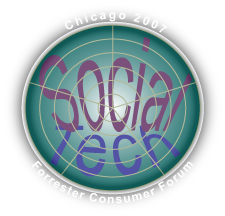Dell and Procter & Gamble Innovation Leaders Share Web 2.0 Transformation Insight—The Slow Boil
 The Global Human Capital Journal’s coverage of the Forrester Consumer Forum 2007 continues with this session on what I’ll hazard to call Innovation 2.0 ,^). David Armano of Critical Mass moderated this an infectious session. It was clear that Proctor & Gamble’s Stan Joosten and Dell’s Manish Mehta had been in the innovation trenches, and their comments were extremely valuable.
The Global Human Capital Journal’s coverage of the Forrester Consumer Forum 2007 continues with this session on what I’ll hazard to call Innovation 2.0 ,^). David Armano of Critical Mass moderated this an infectious session. It was clear that Proctor & Gamble’s Stan Joosten and Dell’s Manish Mehta had been in the innovation trenches, and their comments were extremely valuable.
A key ingredient to Web 2.0’s transformational potential is that the technology is an order of magnitude more explicit, easy to use and less costly. It’s possible, and desirable in many cases, to take small steps. On the other hand, Dell took a risky step in launching Direct to Dell in the midst of serious customer service problems, and it leveraged blogs to turn the situation around.
The Global Human Capital Journal published the overall conference wrap as well as in-depth coverage of several sessions. Access all through the link to the conference logo (right). Other articles will be published in the days ahead, and we invite you to subscribe to the forum’s RSS feed to be notified as they are published.
The Meaning of “Always in Beta”
- Manish: you have to escape “corporate terminal velocity”; if you innovation about 3 times faster than the enterprise can absorb, that’s an optimal speed. To do this, the enterprise must create a special space in which people can operate differently. When you select an “innovation” to incorporate into the enterprise, you often have to adjust it (so that it’s appropriate for enterprise speed). When he was saying this, I thought about deep sea diving; you have to come up slowly to avoid “the bends.”
- Stan: you are never finished. The landscape is always changing, and start-ups are always introducing new possibilities, from undefined spaces. YouTube, Twitter.
Approach to Innovation
- Stan: innovation is a core strategy at P&G. Most people think of us as a consumer product company, but innovation goes beyond products. We seek to innovate around products, to services (and how consumers use them in their lives). Our CMO wants marketing to add value to products. Marketing has been the same old thing forever. Our vision is to actually add value to the product. We have premium brands, and innovation is part of our promise. Innovate everywhere. Also, we have a mandate to source 50% of innovation from outside P&G. We already crowdsource (chemical) engineering, and we intend to do it with marketing.
- Manish: Dell approaches innovation by incubating ideas inside the company. The social media space—RSS, Twitter—is enabling motivated, passionate people to emerge and come together. Passionate people are our secret sauce. Dell Online has a partnership with Corporate Communications; we are willing to take risks. A (critical success factor) in innovation is finding the passionate people within the organization.
- Stan: (as to whether your company should use blogs, wikis and the other enterprise 2.0 tools) Gen Y comes in and says, “Why isn’t it here?” (This is how we work). We have to educate executives and let people do it. Our blogs started on a $1,500 old server. Now we have 200 blogs, and we spend zero on promoting blogging. The blog site is now the hottest intranet site (in the company). Go do it. Innovation is contagious.
How to Measure Innovation’s ROI
- Manish: Michael Dell wanted us to do it (their version of “damn the ROI, full speed ahead”). You have to create the culture inside to deal with the outside. In general, Dell is very ROI-driven, but we’ve kept ROI off the table for the time being. Innovation can show sentiment changing. For example, negative comments about Dell are falling. (Even though we can’t put a price on that, we know it’s valuable).
- Stan: P&G is very data driven, and ROI type measurements are very appropriate for stable processes. If your process isn’t stable (as is the case for emerging activities and developments), ROI isn’t relevant. You need results, like when your numbers go up (but you don’t have to monetize them to the cent). You can get away with this when you organize innovation into small chunks. (If you have big ticket items, that will put pressure to show a financial return.) Innovation is the biggest strategic idea.
- David: Critical Mass has seen value from its “thought prototyping” process on its sites (blog and wiki functionality).
How to Warm Senior Marketers to (Discontinuous) Innovation
- Manish: most marketers are not ready for open innovation. When we put up (Direct to Dell), it had 1.3 million members (and a high portion of negative comments). He almost got fired. (marketers got extremely upset, but he had support from the top, and numbers of negative comments are dropping significantly; everyone can see the progress).
- Stan: People are commenting negatively anyway. It’s better to be in contact with what’s really happening. Be aware of the intent.
Admired Companies
- Stan: Dove, what they’ve been doing with the “real beauty” campaign. Dell for their risk-taking.
- Manish: Apple for their design.
- Stan: the worst mistake with innovation is when we don’t let go of control. With innovation, you have to let people learn. (Innovation is) a different learning process.
- Karl Long of Nokia (during Q&A): a big issue is, how do you give permission to fail (in a highly competitive company)?
- Manish: you must allow innovation to fail. We think about keeping it within a usable sweet spot. If you innovate 5 times faster than the enterprise can absorb, you’re wasting effort. (And, if you’re innovating at the speed of the enterprise, you’re not innovating).
- Stan: all this depends on your definition of failure. Business results are derived from stable processes. You have to put innovation in another category (because it’s discontinuous). Chunk it and don’t spend so much in one place.
Analysis and Conclusions
- Web 2.0 is a very innovative proposition, and speakers captured it extremely well. It’s transformational, but it’s not a “big ticket tech item.” This risk is not in terms of cost, but rather it is about collaborating with new parties (sharing control with customers). Blogs and wikis enable emergent organization, yet the software is abstracted enough to deal with it. Web 2.0 tools are very inexpensive compared to “enterprise solutions.”
- The biggest thing in the market for 2008 will be tagging. People, following a discontinuous process that enables them to work at the lowest transaction cost, will organize everything with tags.
- By having small chunks, you can diminish the pressure to submit to ROI type metrics. This is simple yet profound.
- It may not sound like much, but it’s a pearl: innovation is not a continuous process, so don’t treat it like one. Stan’s advice was sound, in my experience: keep investments low, but don’t burden with ROI-type metrics. It’s a different category. That doesn’t mean you can be irresponsible.
- I loved Manish’s metaphor of “corporate terminal velocity“: you have to keep innovation within the window of applicability, but also have an open mind about “applicability.” P&G has the right idea by thinking outside the product and not restricting innovation to the product: as I’ve written for years, value will be created in terms of customer experience. Products and services are, in the end, only means to better experience.


I also thought David Armano’s panel was “infectious.” Thanks for sharing the wrap up.
Thanks for your kind words. This was such an inspiring panel. I suggested to the Forrester folks, why not have Manish moderate a panel of lead D2D members? That would have blown the whole conference wide open!
Cheers- Chris
[…] Always in Beta: How big Business Can Benefit from “Little” Innovation chronicles a fantastic session with visionaries at Procter & Gamble and Dell at Forrester Consumer Forum. It highlights their pragmatic advice for making corporate innovation (no, not necessarily an oxymoron) work. […]